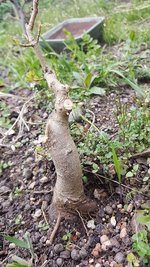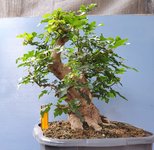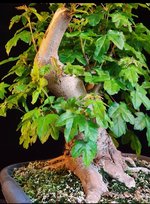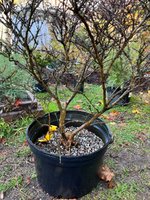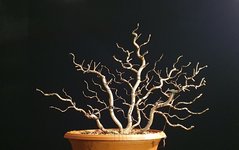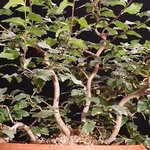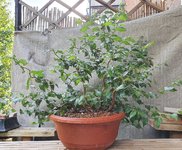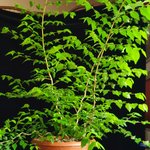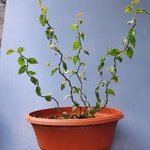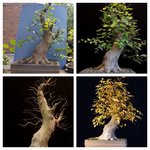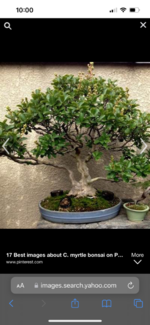So, you bring home a new tree. You like the basic features of the trunk, but it's not nearly as fat as you'd like. Do you simply let the tree grow wild until it bulks up? As the old adage goes - small bonsai don't become big bonsai (or something like that). I just need a reality check. So much of what I see here is more like - buy a tree, start pruning down to a nub. But how does one ever achieve a 3" trunk from a 0.5" trunk by constantly snipping? If my goal was just to add size, shouldn't I be growing it for a while and revisit the tree in a few years to start pruning back and worrying about branch structure later?
You are using an out of date browser. It may not display this or other websites correctly.
You should upgrade or use an alternative browser.
You should upgrade or use an alternative browser.
Growing out the Tree - Reality Check
- Thread starter dbonsaiw
- Start date
Srt8madness
Omono
Tbh I'm not really sure where you've seen that particular advice here. I've learned quite the opposite from these forums - build the trunk, then primary branching, then secondary branching. Grow in the ground or bigger pot to increase trunk size, and grow untrimmed sacrifice branches. Do chops of deciduous to build taper, being mindful their is a balance between how large the chop is and how long the scar will take to heal.
Some trees like Pines you sorta have to do both, keep some foliage short while thickening the trunk with a sacrifice.
Some trees like Pines you sorta have to do both, keep some foliage short while thickening the trunk with a sacrifice.
BobbyLane
Imperial Masterpiece
Yes, in the groundSo, you bring home a new tree. You like the basic features of the trunk, but it's not nearly as fat as you'd like. Do you simply let the tree grow wild until it bulks up? As the old adage goes - small bonsai don't become big bonsai (or something like that). I just need a reality check. So much of what I see here is more like - buy a tree, start pruning down to a nub. But how does one ever achieve a 3" trunk from a 0.5" trunk by constantly snipping? If my goal was just to add size, shouldn't I be growing it for a while and revisit the tree in a few years to start pruning back and worrying about branch structure later?
Attachments
penumbra
Imperial Masterpiece
Do you have a tree in mind? If you do, a picture would help.
BobbyLane
Imperial Masterpiece
BobbyLane
Imperial Masterpiece
eugenev2
Shohin
One of the first things i learned from this forum was someone mentioning that you "have to grow them big to grow them small", i forget who it was, but this advice stuck with me. It really changed my understanding of bonsai, I've realised bonsai is closer to chess than anything else, you need to think a number of moves ahead to plan the way forward. But there is an argument to not simply leave a tree to grow "wild" as this could result in some undesirable growth.So, you bring home a new tree. You like the basic features of the trunk, but it's not nearly as fat as you'd like. Do you simply let the tree grow wild until it bulks up? As the old adage goes - small bonsai don't become big bonsai (or something like that). I just need a reality check. So much of what I see here is more like - buy a tree, start pruning down to a nub. But how does one ever achieve a 3" trunk from a 0.5" trunk by constantly snipping? If my goal was just to add size, shouldn't I be growing it for a while and revisit the tree in a few years to start pruning back and worrying about branch structure later?
Sometimes the hamster falls asleep at the wheel, so bear with me. Here's a myrtle I have that I think is a good example of what I'm trying to ask. I will be repotting come spring (the bonsai soil is just a dressing in the pic and there's potting soil under it). I like the base and the basic form of the trunk - it is not my intention to chop below where the main trunk starts to split. In fact, I like the form of the tree even above the split. The lower shoot is too large and will need to be pruned back at some point.
As I debate where to cut back, I started to ask myself why cut back at all in the upcoming season(s). I think this tree would benefit from being considerably more girthy lower down.
The issue is one of lack of orientation. We are always cutting back and growing - I just get confused if I am in the cutting or growing phase with a particular tree at a particular time. Given my intentions with this tree, I seem to be in the growing stage. But it's bonsai, and if you spin me around I get lost easy.
As I debate where to cut back, I started to ask myself why cut back at all in the upcoming season(s). I think this tree would benefit from being considerably more girthy lower down.
The issue is one of lack of orientation. We are always cutting back and growing - I just get confused if I am in the cutting or growing phase with a particular tree at a particular time. Given my intentions with this tree, I seem to be in the growing stage. But it's bonsai, and if you spin me around I get lost easy.
Attachments
MHBonsai
Chumono
What helps me is to focus on the final image. You may not know what you are shooting for yet - but once you can put a sketch on paper, or just visualize in your mind what you want it to be...all your decisions get easier.
If you want this tree to be a squat shohin sumo, it may be ready for a much smaller pot, a hard chop and some serious root work. If you see this tree as a tall elegant feminine shape, you may want to keep extending one leader, heal your chops and put it in a wide flat pot. If you want it to be a giant 'fairytale' tree with a girthy big trunk...she goes in the ground. Thinking in that manner always helps me.
If you want this tree to be a squat shohin sumo, it may be ready for a much smaller pot, a hard chop and some serious root work. If you see this tree as a tall elegant feminine shape, you may want to keep extending one leader, heal your chops and put it in a wide flat pot. If you want it to be a giant 'fairytale' tree with a girthy big trunk...she goes in the ground. Thinking in that manner always helps me.
eugenev2
Shohin
I think this is something Peter Chan touches on in one of his videos, he once mentioned that he doesn't like using terms such as in development or in refinement, because to him the trees are constantly growing and constantly changing. He then went on to show one of his famous cascade trees which after a number of years of designing...it think it was 40 or so years. The cascade branch broke off and the entire design had to change and a very old and "refined" tree was back in developmentSometimes the hamster falls asleep at the wheel, so bear with me. Here's a myrtle I have that I think is a good example of what I'm trying to ask. I will be repotting come spring (the bonsai soil is just a dressing in the pic and there's potting soil under it). I like the base and the basic form of the trunk - it is not my intention to chop below where the main trunk starts to split. In fact, I like the form of the tree even above the split. The lower shoot is too large and will need to be pruned back at some point.
As I debate where to cut back, I started to ask myself why cut back at all in the upcoming season(s). I think this tree would benefit from being considerably more girthy lower down.
The issue is one of lack of orientation. We are always cutting back and growing - I just get confused if I am in the cutting or growing phase with a particular tree at a particular time. Given my intentions with this tree, I seem to be in the growing stage. But it's bonsai, and if you spin me around I get lost easy.
Shibui
Imperial Masterpiece
There are always a number of different approaches to achieve similar results and different growers wills wear by their own favourite method.
Lots of advice to 'let it grow' to achieve quick thickening. That certainly achieves thickness but bonsai is not all about trunk girth. We also value taper and trunk movement. @eugenev2 is correct that
Grow and chop may not achieve girth quite as quick as untouched free growth but the following stage of healing the scars and developing apex is already well under way after years of chop and grow so I end up with the final result much quicker by taking this path.
I would not chop that myrtle below where the main trunk splits as that's already a good feature.
If the smaller trunk is getting too long or too thick chop it while allowing the other trunk to grow. That should give different relative growth rates on each trunk, add some branching and/or bends in the smaller one. When back in balance both can be allowed to grow to achieve better thickness.
Try not to see all present branching as part of the final bonsai. Much will change in trunk lines and most branches and lots of the trunk will be chopped at some stage as sacrificial growth promoting. The final bonsai is often made of shoots that have yet to emerge.
Lots of advice to 'let it grow' to achieve quick thickening. That certainly achieves thickness but bonsai is not all about trunk girth. We also value taper and trunk movement. @eugenev2 is correct that
After years of trials and many errors I now favour the approach that @BobbyLane shows above. Repeated bouts of free growth to add thickness along with chops every year or 2 to get taper and bends into the developing trunk. Not 'constant snipping', more like intermittent snipping to allow some growth.there is an argument to not simply leave a tree to grow "wild" as this could result in some undesirable growth.
Grow and chop may not achieve girth quite as quick as untouched free growth but the following stage of healing the scars and developing apex is already well under way after years of chop and grow so I end up with the final result much quicker by taking this path.
I would not chop that myrtle below where the main trunk splits as that's already a good feature.
If the smaller trunk is getting too long or too thick chop it while allowing the other trunk to grow. That should give different relative growth rates on each trunk, add some branching and/or bends in the smaller one. When back in balance both can be allowed to grow to achieve better thickness.
Try not to see all present branching as part of the final bonsai. Much will change in trunk lines and most branches and lots of the trunk will be chopped at some stage as sacrificial growth promoting. The final bonsai is often made of shoots that have yet to emerge.
BobbyLane
Imperial Masterpiece
Yup, as Shibui put it, repeated bouts of free growth is the mantra and trees in pots are treated the same way. on vigorous trees you set up your branch structure or set the primary lines then you allow free growth for these branches to thicken then cut back, allow free growth again, all the time keeping an eye on the tree, looking out for potential problem areas especially on field growing trees.
if you studied Mach5's or Walter palls progression threads for example, and they have many. you could clearly see how important free growth is. its crucial for development, fast development.
the primary trunks on that elm clump were thickened quite considerably in just one season of allowing free growth and daily feeding.
if you studied Mach5's or Walter palls progression threads for example, and they have many. you could clearly see how important free growth is. its crucial for development, fast development.
the primary trunks on that elm clump were thickened quite considerably in just one season of allowing free growth and daily feeding.
Attachments
Joe Dupre'
Omono
Pruning anything off of a tree always slows it down. Less foliage or roots equals less growth. A big root ball in a bonsai pot would be 12" to 14" long by 10" wide by 3" deep for a trunk that's say 2"-3" in diameter. That same tree in the ground might have a root ball 5 feet by 2 feet deep. The amount of additional potential growth in the ground is tremendous. I think it's best to grow a tree in the ground until it's really close to your preferred finished size, maybe planted over a tile to give a flat root ball. When it's as big as you want it, treat it like a yamadori, collect it and start growing the branches out. You CAN grow a big trunk in a bonsai pot, but it may take 30 years.
Mike Corazzi
Masterpiece
If you start with a small one that's rather nice, the 30 years will pass pleasantly.
The time to be selective is at the nursery when you can toss aside the uglies.
The time to be selective is at the nursery when you can toss aside the uglies.
You hit the nail on the head - I don't see what I want from this tree and, therefore, don't yet know where to go from here (may help if I actually see a myrtle grow in person).You may not know what you are shooting for yet - but once you can put a sketch on paper, or just visualize in your mind what you want it to be...all your decisions get easier.
This discussion was very helpful. Still another 2 months of winter, so plenty of time to stare at the tree.
In my search for some inspiration, I came across the attached tree which has similar features to mine. To my untrained eye, it looks as if I could simply hedge trim my tree and put it in a pot and they would look similar. Not sure what I think about it just yet, but my initial reaction was that the proportions were a bit off and made it look like a small hedge as opposed to a bonsai. But I go back and forth on that. Interestingly, I purchased my tree from a local bonsai shop - they picked up a few from another nursery and they were still in the nursery pots when I got mine. I went back to the bonsai shop a few weeks back and the myrtles were hedged, roots reduced and placed in bonsai pots (with a much higher price tag). Something tells me I can do better than a simply hedge on this younger material.
Attachments
Cajunrider
Imperial Masterpiece
That is my way of doing things. I will grow or collect a 10-20 ft tree, reduce it to 10-20" tree, then try to make it look like a 100 ft tree.One of the first things i learned from this forum was someone mentioning that you "have to grow them big to grow them small", i forget who it was, but this advice stuck with me. It really changed my understanding of bonsai, I've realised bonsai is closer to chess than anything else, you need to think a number of moves ahead to plan the way forward. But there is an argument to not simply leave a tree to grow "wild" as this could result in some undesirable growth.
BobbyLane
Imperial Masterpiece
You hit the nail on the head - I don't see what I want from this tree and, therefore, don't yet know where to go from here (may help if I actually see a myrtle grow in person).
This discussion was very helpful. Still another 2 months of winter, so plenty of time to stare at the tree.
In my search for some inspiration, I came across the attached tree which has similar features to mine. To my untrained eye, it looks as if I could simply hedge trim my tree and put it in a pot and they would look similar. Not sure what I think about it just yet, but my initial reaction was that the proportions were a bit off and made it look like a small hedge as opposed to a bonsai. But I go back and forth on that. Interestingly, I purchased my tree from a local bonsai shop - they picked up a few from another nursery and they were still in the nursery pots when I got mine. I went back to the bonsai shop a few weeks back and the myrtles were hedged, roots reduced and placed in bonsai pots (with a much higher price tag). Something tells me I can do better than a simply hedge on this younger material.
Imo that is one of the best ways to hone your vision, seeing something similar to yours or similar to yours 'when it was started' seeing what was done to move it on. keep doing that, not just with this tree but with all of your trees. and there will always be a tree, a shrub or a bonsai that looks similar to yours to draw inspiration from, thats the way nature is. store these images on your drive, refer back to them, bookmark them. in Croatia they have some amazing yamadori myrtle, this is one by Andria zokic. just because its a huge yamadori doesnt mean you cant draw any inspiration from it, in fact it could just be a bigger more gnarly version of what yours could be, maybe that type of canopy is something to aim for, it shows what is achievable with the species right. the base is pretty typical of shrubby material, you'll find this type of base on olives to, or pistacia trees

eugenev2
Shohin
It could be you that i'm referencingThat is my way of doing things. I will grow or collect a 10-20 ft tree, reduce it to 10-20" tree, then try to make it look like a 100 ft tree.
tdesaul
Seedling
- Messages
- 5
- Reaction score
- 1
wait....so...I'm a total noob who joined the forum today.
Let me get this straight:
If I want a thick trunk, then I need to let it grow in a big pot/or the ground?
I assume that I'm also pruning the tree to keep the height where I want it, correct?
What happens to the little bonsai Juniper I bought in a bonsai pot? Will it never thicken up?
Let me get this straight:
If I want a thick trunk, then I need to let it grow in a big pot/or the ground?
I assume that I'm also pruning the tree to keep the height where I want it, correct?
What happens to the little bonsai Juniper I bought in a bonsai pot? Will it never thicken up?

john blanch
Yamadori
Bonsai being kept restricted in pots will increase in trunk and branch girth, but very slowly. However you will be able to keep the bonsai quite refined throughout its life. The snag with wanting a substantial trunk quickly is that after the plant has been given enough space to grow freely and develop the thick characterful trunk, the grower has to have the knowledge and skills to then reduce the rootsphere and branch thickness and a myriad of horticultural and design issues to return the bonsai some refinement.
Similar threads
- Replies
- 4
- Views
- 627
- Replies
- 4
- Views
- 721

